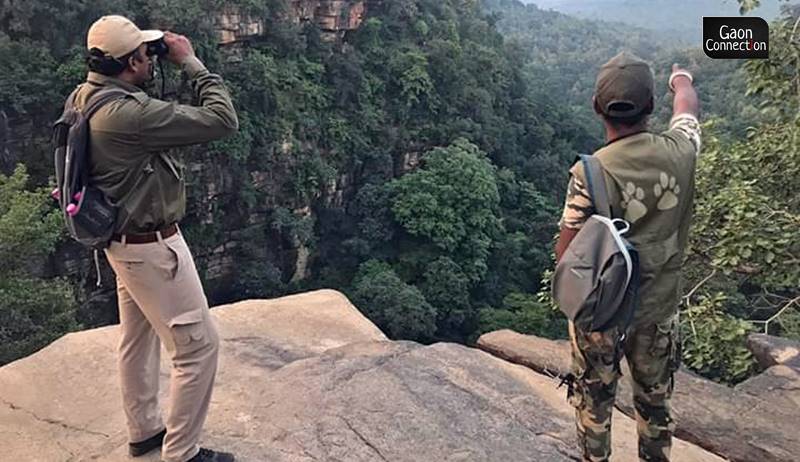Panna, Madhya Pradesh
No one knows the forests and their creatures better than they do. After all, from the time of the Mughals, the nomadic Pardhi tribe has been living in and near the jungles and hunting for a livelihood, an activity that has brought negative perception of the community.
But there has been a complete turnaround and the very same hunting community is now a protector of the wild animals in the jungles of Madhya Pradesh in central India.
Launched in October 2018, the ‘Walk With the Pardhis’ initiative in the Panna Tiger Reserve, takes tourists for a tour in the deep jungles by Pardhi nature guides who are trained by the non-profit Last Wilderness Foundation, active support and encouragement by the forest department . Young members of the erstwhile hunting community are now protectors of the forests and wildlife.
“We wandered from one jungle area to another to hunt prey. But, now our familiarity with the forests and the animals is holding us in good stead and we have a steady income,” Viren Pardhi, a nature guide of the Panna Tiger Reserve, told Gaon Connection. The 36-year-old added that it gave him immense satisfaction when he accompanied tourists deep into the jungles and educated them about the flora and fauna.
Also Read: Vatsala, Panna Tiger Reserve’s senior- most citizen is more than a 100 years old
Pradhis: Criminalised and marginalised
Pardhi, derived from the Marathi word ‘paradh’, means hunting. Traditionally, they are nomadic hunter-gatherers and experts in using bows and arrows and setting traps for animals.
When they rose against the British, they were branded as a tribe of ‘criminals’ under the Criminal Tribes Act in 1871. It was only as late as 1952 that the tribe was denotified by the Indian government. But, its members continue to be marginalised and face discrimination. The ‘criminal’ tag refuses to go away.
But, the ‘Walk with Pardhi’ initiative of Mumbai-based Lost Wilderness Foundation, which works closely with the Pardhi people in providing education for their children and drawing them into tourism initiatives, is trying to change that negative perception .
Pardhis who have lived close to nature for hundreds of years and have mastered the art of imitating bird and animal calls, can easily recognise pugmarks of animals and identify every blade of leaf in the forests. Members of the community are using this traditional knowledge to give tourists an in-depth introduction to the forests of Panna.
“We have been hunting in the forests since the time of the Mughals. I can’t say how many animals our ancestors must have hunted down,” Toofan Singh, a Pardhi, told Gaon Connection. The 70-year-old is the oldest inhabitant of Gandhigram village, located about seven kilometres from Panna, where there are about 70 Pardhi families living.
Also Read: Tiger Dad wins custody of his cubs at Panna Tiger Reserve
From hunters to nature guides
The Pardhis continued to hunt till 2008-09 when the tiger population at the Panna Tiger Reserve and the nearby forests came close to extinction.
It is then that the forest department sought to rehabilitate them and open up new avenues of livelihood for them and get their help in conservation.
Since then there has been a transformation in the community’s lifestyle, which, rather than hunting, is now protecting the wildlife and educating visitors about the jungles. The forest department on its part has proactively provided them with habitation at Gandhigram village and made arrangements for the education of the children.
Meanwhile, the youth in the community have been trained by the forest department as nature guides which helps them earn a regular income .
Also Read: When women forest officers run a zoo
“When our children were trained to become nature guides, we stopped hunting. We had other means of livelihood,” Toofan Singh said.
Walking with the Pardhis
‘Walk With Pardhis’ takes tourists to the Ranipur gorge inside the Panna Tiger Reserve, which is the habitat for the state bird, dudhraj or the Indian paradise flycatcher or Shah Bulbul as it is also called.
“Besides the dudhraj, this area is also a favourite haunt of owls, Indian pitta, hornbill, cuckoo and several other species of birds, including the near-extinct vultures,” Indrabhan Singh Bundela, field coordinator of the Lost Wilderness Foundation, told Gaon Connection. “Even tigers are spotted here,” he added.
On June 21, Gaon Connection, accompanied by 32-year-old Badda Pardhi, 22-year-old Ratni Pardhi and 23-year-old Dishavari went deep into the Panna Tiger Reserve up to the Ranipur gorge. The trek was made even more exciting as the Pardhi guides constantly pointed out rare birds and flora and provided amazing information and insights about forest life.
So familiar and in tune with the forests and its creatures are they that the Pardhi nature guides know exactly where to spot certain animals and what to look out for. When they imitate bird calls, the birds actually respond to them.
“We get paid for accompanying tourists inside the forest. There is no fixed amount but most of them pay us up to hundred rupees each,” Viren Pardhi said.
“The Pardhis had no other skill but hunting. But the forest department has taken a lot of interest in training the younger generation into becoming nature guides,” Uttam Kumar Sharma, field operator, Panna Tiger Reserve, told Gaon Connection.
According to Sharma, there is a school and a hostel for the children of the Pardhi community. “We are constantly encouraging the youth to become nature guides,” he added. The Pardhis are a de-notified, nomadic or semi-nomadic tribe who are also present in large numbers in other parts of Madhya Pradesh. “The jungle is a source of their livelihood and because of this they ensure no illegal activity takes place in the forests,” Sharma said.
Apart from Madhya Pradesh, Pardhis are also found in Maharashtra and also parts of Gujarat and Andhra Pradesh.
There are approximately 10,000 Pardhi people in Madhya Pradesh, Bundela told Gaon Connection. “The Pardhis in Bundelkhand in Madhya Pradesh now have ration cards as well as Aadhaar cards. They can vote too,” he added.
According to Bundela, in Bundelkhand region the Pardhi community largely lived in Panna, Katni, Chhatarpur, Damoh and Sagar. They are also present in Hoshangabad, Dindori, Mandla, Jabalpur, Bhopal, Vidisha and Nivad, he said.
Social change through modern education and traditional knowledge
Sijaran Pardhi is perhaps the most educated in the Pardhi community. The 31-year-old is doing her final year Bachelor of Arts at the Mahatma Gandhi College in Satna.
“My husband Badd Pardhi is a nature guide. When I come to Gandhigram, I teach the other kids there, and many of them now want to study further in towns and cities,” Sijaran told Gaon Connection.
The Pardhis are in complete tune with the flora and fauna of the forests they frequent. The knowledge they have about wild medicinal herbs and plants is also hereditary. Many women from the community go village to village selling herbal remedies.
Also Read: Rural women put Panna’s amla on the murabba map of India
“Our elders have imparted the knowledge of the herbs to us and we make medicines out of them,” Kilkili Bai, a Pardhi woman from Panna, told Gaon Connection.
With the onset of the monsoon, the main Panna Tiger Reserve will be closed on June 30 and will reopen on October 1. But tourist activity and guided nature tours by Pardhis will continue in the Ranipur forests.
The Ranipur forest forms a corridor between the Panna Tiger Reserve and the Ranipur Wildlife Sanctuary that falls in Chitrakoot in Uttar Pradesh. It is a corridor frequented by tigers, Bundela said. In 2015, a tigress from the Panna Reserve had wandered into the jungles of Chitrakoot, he added.
Once the pandemic dies down, plan a trip to the jungles of Panna and learn about their flora and fauna from the Pardhi nature guides. They may teach you to imitate bird and animal calls; or identify pugmarks.
Read the story in Hindi.



















